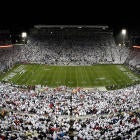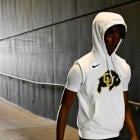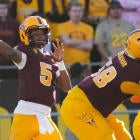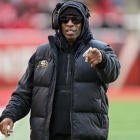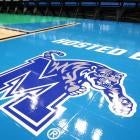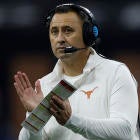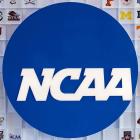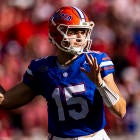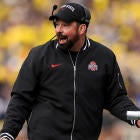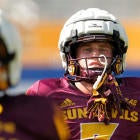What projects as the largest collaboration between coaches and training/medical staff in college football's history is in the process of safely -- and quickly -- preparing the sport for an on-time start to the 2020 season.
As the coronavirus persists, that effort includes numerous plans to start college football, the first being an attempt to begin with fall camps opening as scheduled around Aug. 1. Such a return includes the possible adjustment -- some may say "disposal" -- of longstanding, safe return-to-play guidelines. Specifically, two-a-day practices -- banned in 2017 -- could return for the preseason session.
While a timely start to the 2020 season remains in question, the conversation needs to be more about how to get to kickoff than when. Latest guidelines call for an acclimation period (7-10 days) for players prior to any formal football drills taking place. Guidelines introduced last year call for a "safe and effective framework" in order to ease players into strenuous workouts.
That would put the return-to-practice date at approximately July 15. Some say the so-called "drop dead" date for starting the season on time should be much earlier.
"I think we have to be willing to be nimble while still maintaining the standards of safety," said Brian Hainline, the NCAA's chief medical officer.
The three camps involved in the return-to-play decision -- coaches, trainers and medical personnel -- don't always mesh perfectly. They can't afford to get this one wrong in the face of the coronavirus pandemic.
"That is my biggest fear," said Rod Walters, a hall-of-fame trainer and NFL head trauma consultant. "If we don't handle this thing right, it's going to be another exertional heat death."
Since the turn of the century, the leading cause of death in the sport has essentially been offseason football with 33 players dying between 2000-16. The overwhelming majority (27) occurred in the offseason while players were working out in shorts and T-shirts. Since then, an avalanche of guidelines, position statements and recommendations from training and sports medicine have sought reform.
The coronavirus has turned up the pressure to answer college football's most pertinent question: When can we get back on the field?
That question will be answered by a combination of coaches who win with athletes, trainers who prepare athletes to win and medical personnel who treat those athletes on and off the field.
They all put the players' welfare first, but this task comes with an ongoing pandemic in the background and the unspoken pressure of getting the financial engine that is football back to fueling to college athletics as a whole.
"We have to find a way to play the season -- financially more than anything," Kansas State coach Chris Klieman said. "It will help every other sport. It will help the university."
An on-time, early-August start -- essentially going from zero to 60 in athletic terms -- would come less than 14 months after the NCAA's released specific catastrophic injury guidelines. The recommendations were developed as an answer to the nearly three-dozen deaths since 2000.
Now, the challenge becomes not only cleaning up the game but getting it back on the field. A coach/trainer/medical collaboration is deemed so essential that one prominent Power Five trainer quoted President Abraham Lincoln in this potential battle: "A house divided against itself cannot stand."
"The unprecedented thing would be the collaboration of coaches, medical folks and trainers on the front side," said Randy Cohen, Arizona's senior associate athletic director for medical services. "There is unprecedented planning ahead. … This is no different than the President and the Congress. The best way is, today, to throw out your agenda and work together."
Cohen believes practices can start safely Aug. 1 even with players essentially going directly from shelter in place to the field. However, not all players may be physically ready for practice when starting from scratch on that date. Cohen compared such a swift return to athletes recovering from an injury easing back into the lineup .
"My quarterback may be ready, but my two receivers may be ready to play only half the game," Cohen said.
That's where the balancing act comes in. Since 2000, players have spent more time training on campus in the offseason. In doing so, they were sometimes were pushed too far.
Three years ago, August emerged as a peak month for in-practice concussions with 58 percent of a year's total happening that month alone, according to NCAA research. Now, research shows those previously banned two-a-days may be OK in August -- or whenever the game returns, according to Hainline.
"It really doesn't make any sense," said Scott Anderson, Oklahoma's hall-of-fame head athletic trainer. "I don't know what science Brian is pulling from either because, the science I read, it's not specific to one-a-days vs. two-a-days, but it's specific to preseason. … Reduce concussions? No, they haven't."
Hainline responded: "We now understand head impact exposure better, and we have catastrophic injury safeguards in place. But that does not translate into legislative changes. I was thinking out loud as someone who understands the data and who understands the nimbleness and out-of-the-box thinking that might be necessary."
The conflict highlights a major reason why college football is the only NCAA sport with its own medical return-to-play guidelines.
At this point, just suiting up to play the 2020 season will qualify as a positive.
"I'm cautiously optimistic we can get a season in," said Hainline, now in his eighth year as the NCAA's chief medical officer. "I look at New York as an example. The city was decimated, but we are actually starting to see some light. But it took exceptionally aggressive measures. It's going to take not relaxing them all at once."
The Trump Administration has indicated sports in general is important to reopening the economy. Hainline was generally supportive of the administration's phase-in level of opening certain states.
"We are going to have to be in this constant state of readiness," Hainline said. "That state of readiness means that no one with any symptoms would ever report to practice. People with symptoms are tested right away. If they test positive, they are isolated."
A return-to-play date is further complicated because it would require various stakeholders to massage or reimagine the amount of preparation time that is deemed "safe."
AAC commissioner Mike Aresco said a "consensus" is forming around a July 15 return to formal in-person, on-campus workouts. That would give teams starting in Week Zero (Aug. 29) slightly more than six weeks to get ready.
Several coaches, including Oklahoma's Lincoln Riley, have said they could pick up and start from scratch in early August. Riley said he would need only 15-20 practices.
Somewhere in there is an absolute: The NCAA now recommends that week-plus acclimation period at the start of practice with no contact for athletes to ease into strenuous exercise.
June 2019 guidelines from two major strength and conditioning organizations call for focus on a safe return to play in the first 2-4 weeks of drills. While such a zero-to-60 start is not recommended, college football may have no other choice if it hopes to get the season started on time.
"We've got enough intelligent people ... to make sure we never put a student-athlete in harm's way," said Iowa State coach Matt Campbell.
Therein looms that sometimes-adversarial relationship between coaches, trainers and medical personnel. The training community howled when Texas A&M coach Jimbo Fisher fired two long-time athletic trainers in 2018. An ESPN report said the firings were "in direct violation of NCAA policy."
That policy states that sports medicine personnel have "unchallengeable authority" over coaches in return-to-play decisions regarding players. The American Football Coaches Association code of ethics stresses the independence of medical personnel apart from the coach. "A coach should not involve himself with the diagnosis of any injury," it reads.
The game's watchdogs have worked doggedly on the independent authority of sports medicine personnel for more than a decade.
In 2009, NCAA schools had to document a limit of 20 hours spent weekly by athletes on their sports. A National Association of Athletic Trainers position statement addressed the issue of sudden death in college sports. There were Safety in College Football Summits held in 2014 and 2016. In 2014, the NCAA partnered with the Defense Department on a concussion research consortium. A 2017 study further recommended independent medical care.
Out of that came the NCAA edict: "Two-a-day football practices should not occur."
That could change if the calendar is squeezed enough.
"We have so much more data now, catastrophic injury data," Hainline said. "There may be imaginative ways to move into that world if need be."
Cohen was dead set against the return of two-a-days. Then he thought: If one of the practices are unpadded and don't involve hitting, why not? Instead of one three-hour practice in preseason, break them up into two 1 ½-hour drills. They would have to be closely monitored and documented, but it just might work.
"Based on what [the NCAA is] seeing, two-a-days may have not been the issue with concussions," said Shane Lyons, West Virginia athletic director and chair of the Football Oversight Committee. "It may have been the repetitive head hits. The numbers appear to be the same whether you had two-a-days or not."
While the NCAA is working on how to start the season, all the conferences are modeling their own return to play. A veteran like former Michigan State strength & conditioning coach Ken Mannie is already on record.
"I would hope and pray players would get a good 7-8 weeks of training in [before camp]," said Mannie, who recently retired after 25 years with the Spartans. "That would mean coming back in June prior to reporting to camp. Anything less than that it will be difficult."
Colorado College strength coach Scott Caulfied said three months of structured strength training before camp would be optimal. For eight years, Caulfield was head of the National Strength and Conditioning Association.
If not?
"You're probably going to have more soft tissue injuries from coming back too quickly," Caulfield said. "You're just not going to be in shape. Not being in shape leads to potential overuse."
That describes both the high stakes involved in such an endeavor and the sometimes-conflictive history of those three entities.
College athletes have essentially been learning and training remotely since the NCAA Tournament was canceled on March 12. Last week, the NCAA banned all virtual workouts as a safety concern.
"When it comes to doing workouts, there is someone on site who can take care of you when you are ill," Hainline explained. "Virtual workouts don't have that in there."
What's becoming clear is that a return to play will be that collaboration between those 10 FBS commissioners, the AFCA, the NCAA's newly formed medical advisory panel, its College Football Oversight Committee, the Competition Oversight Committee, the Competitive Safeguards Committee and the Board of Governors, the NCAA's ruling body.
"What we don't want to do is be all disorganized and all the sudden there is a green light to play and all sudden we say, 'What the hell? We weren't prepared for this,'" said Wyoming coach Craig Bohl, a member of the AFCA board of trustees.
Dr. Carlos Del Rio is a member of that advisory panel. Emory University's head of global health has been a transparent voice on the subject of when college football could return.
It doesn't look good.
Sobering from NCAA Dr. Carlos Del Rio: "I hate to say it but for this calendar year, we may never return to normal without a vaccine or some strategies in place."
— Dennis Dodd (@dennisdoddcbs) April 11, 2020
It has been widely reported the game's stakeholders have modeled every possible return to play scenario:
- An on-time start
- A delayed start that would push back a full regular-season deeper into December
- A shortened season that could include conference games only
- A two-semester season that would begin in the fall and end next year
- A spring 2021 season that would mean two seasons in a calendar year, presenting a player safety question regarding return to play for that fall
"To me, the first question you have to ask is what happens to the [second] 2021 season?" said Texas A&M AD Ross Bjork. "What's that timing look like?"
Bjork was referring to players potentially having only three or four months to prepare for a second season.
"My brain doesn't work that far out," Hainline said. "That's a cop out for, 'I don't even want to go there.'"
With that many voices molding a new beginning for the sport, cooperation is key.
"What are you going to do the second week of practice at the University of South Carolina if one kid tests positive?" Walters wondered. "Quarantine everybody?"
One medical source at a Power Five athletic department said he is purposely approaching the season positively with players as if it will begin on time. Otherwise, he fears, players will lose motivation and stop going to class.
Nothing happens until all 50 states are on the same page for a return. For example, Oklahoma can't travel to Army-West Point on Sept. 26 if the state of New York is on lockdown.
"California might say [to opponents], 'You can't come here,'" said Dan Hawkins, coach at FCS UC Davis. "We might have to go play Fresno [State]. We might have to go play Cal or Stanford. We might have to go down to UCLA. It might be the all-California bus league. Seriously."
The road ahead is uncertain at best. Once the back of the virus is broken, we may be divided into two classes in this country: Those who have developed antibodies against the disease and those who are still vulnerable. Imagine a college team where different colored jerseys are worn in practice for that reason.
"The worst-case scenario is we move back too quickly and we're back to where we were a month ago from a society level," Hainline said.
At stake is the current model of college football being nearly a year-round sport. Part of Alabama's offseason conditioning routine is called "The Fourth Quarter." Hawkins has been widely quoted for his response to Colorado players and parents who complained about getting only three weeks off in July.
"It's the Big 12," Hawkins famously said. "It's Division I football."
Players have long been conditioned to a spring practice session that can last 1 ½ months with spring break factored in. Spring games have become content -- and profit -- for conference networks. They are also used to sometimes attending two summer school sessions during which strength coaches become the most important staff member. Highly-touted high school prospects enroll early in January in order to get acclimated into that culture and essentially get a head start to the NFL.
The changing culture has not been lost with those who closely monitor the sport. Once the offseason became more regimented -- around 2000 -- the deaths and hospitalizations caused by offseason workouts started to mount.
That model would be impacted -- if not done away with -- no matter when college football returns with less (not more) offseason participation being the likely result. It was suggested to several coaches that it may be a template for doing away with the current culture altogether, including the cancellation of spring practice itself.
Asked about his time as a player at UC Davis, Hawkins recalled "basically [going] three-a-days all the way through our first game."
Anderson says there is a significant "risk factor if is somebody is going to decide, 'We've got to cram 12 weeks into eight. We've got to cram eight weeks into six. We've got to cram six weeks into four."
"Then, you're going to have problems," Anderson added.
Just having an all-clear to play football again would be relief enough.
"We can do this," Cohen stressed. "But everyone will need to check their egos, compromise and work together."












